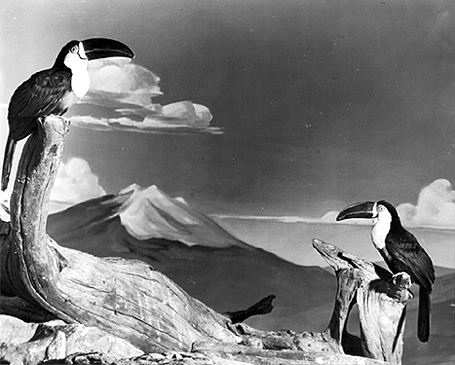

From Bird Calls, The Newsletter of the National Aviary in Pittsburgh, Summer, 1994.
From Jonas Salk's polio vaccine to the miracle of organ transplantation, Pittsburgh has long been recognized as a center for medical breakthroughs. Veterinary care staffers at the National Aviary in Pittsburgh have added another medical marvel to the list--reconstructive beak surgery.
The Aviary's resident Great Indian Hornbill, an endangered species, was the recipient of an amazing surgical procedure. The hornbill, a large and extremely distinctive Southeast Asian bird, arrived at the Aviary from the Bronx Zoo in 1988. The Hornbill already had a primitive artificial beak fashioned by workers at the Bronx Zoo. The crude, fiberglass prosthesis became necessary after the bird flew into a wall and broke its lower mandible.
The normal wear and tear of eating took its toll on the artificial beak, requiring many repair attempts on the part of Aviary Animal Care experts, but they could only do so much with the puttied, weak structure. A group of specialists had been pondering the beak conundrum for the past year when fate intervened. The makeshift mandible fell off late one night in March.
A missing lower mandible spells doom for the Great Indian Hornbill. When eating, this species picks up food with the end of its bill, tosses it up in the air and then catches it in its mouth. Both of the bird's mandibles must touch in order to manipulate the food.
The urgent crisis demanded immediate medical attention. Six specialists, among them two veterinarians, a pediatric dentist, a representative from a South Side dental laboratory and Aviary experts, combined their collective expertise to create an emergency replacement. The new beak was constructed from a new European dental acrylic similar to the orthodontic appliances used in corrective retainers.
The beak team had to modify the prosthesis to insure a proper fit. Lynn Leindecker, the Aviary's Curator of Birds, held the Hornbill on her lap as the dentists maneuvered the acrylic mandible until they were assured the beak was perfect.
The operation, which only took about 50 minutes, was a success. The Great Indian Hornbill has recovered nicely and is learning to live with his bogus beak. The color is incredibly close to that of the natural mandible. Viewers must look very closely to discern the prosthesis from the natural beak.
Responding to the peril of one lone Hornbill, the efforts of Aviary veterinary team and local dental experts have led to the creation of an artificial structure that could aid birds who find themselves in similar dire beak circumstances.